About my paintings
In June 2017 my son Jacob announced that he was getting married. In July. In Hong Kong. Whilst very unexpected and sudden it was marvelous to celebrate his wedding!
Whilst out there I admired some images of traditional Chinese Art, particularly bamboo, and thought wouldn’t it be marvelous too if I could find out a little about some of the techniques they use. So I searched on my phone and found what seemed to be a group of Chinese artists and emailed enquiring about a lesson, not really expecting a response, let alone that it would be possible to have a lesson within the 4 days we had there after the wedding. But I did get a response, from an excellent artist called Winn Siu Davies http://www.asiacontemporaryart.com/artists/artist/Winnie_Davies/Waiting18166/en/
I am glad that as I had phone only could not take a good look at all her fantastic work, and impressive cv, before I had the lesson (on the morning of the day we were to fly home in fact) as I would have too in awe to have the confidence to try it!
Winnie was great. She showed me all the traditional materials: brushes, ink and traditional mulberry paper. The ink in fact used now is Japanese as the Chinese lost the skills for making following the Communist Revolution. But most of all she showed me some key brush strokes. As requested we concentrated just on the bamboo in the lesson. Afterwards, I bought all the materials, including special watercolour paint and teaching book (in English!). Then we flew back. Since returning to the UK I have been practising a Chinese style a lot, supported by Winnie on What’s App. I have brought colour into some of the works. I have put mounts on some of the more successful ones and purchased frames for them. At the time of writing this (August 2017) some of my works are on display for sale in the Ipswich and Suffolk Club, for £60 each.
I intend to do more work in this style and hope to get more confident with it. I am helped also a lot by the fact that I have long been interested in Daoism which is the inspiration for much of traditional Chinese painting.
August 2017
Why did I do a painting of the Ipswich Mayor 2014?
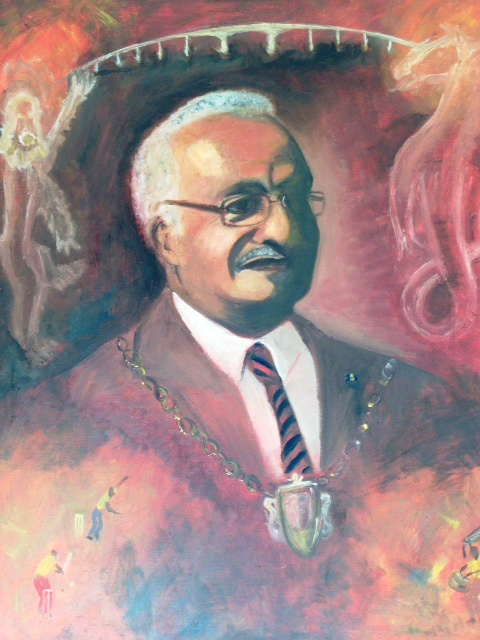
On 13th June 2013 I attended the Drawing Prize at Suffolk New College to give it out (some very good winners too) and afterwards I went round the Summer Show. I went past Shelley’s Restaurant, the excellent restaurant run by the students on catering courses. There were several people outside I knew involved in the Ipswich public sector and business communities about to enter for a meal and they very kindly invited me to join them. It turned out to be a meal of the Ipswich Corporation, which is the governing body of the College, and others involved in its operation. One of the guests on my table was Hamil Clarke MBE, the Ipswich Mayor 2013/14.
We got on well and amongst other things chatted a bit about art (being the occasion of my being at the College that evening of course). On a complete impulse, after the end of the meal as we were departing, I asked Hamil if we would agree for me to do a portrait of him. He was probably a bit taken aback and no doubt, I put him on the spot, as he knew nothing about my skills, or, indeed, whether I had any at all. However, he agreed, perhaps thinking I may not have been serious. I later followed it up with his Office and he remained ok with the idea after hopefully checking me out a bit! Anyway, he did attend my Lame Deer exhibition and talk in the Town Hall in November.
Due to other commitments, I wasn’t able to start serious work on the project until February 2014. But I kept thinking about it, off and on (and certainly, whether I was overreaching myself as an amateur artist!) I wanted to a painting in the same style as Lame Deer with some symbols which represented the Hamil’s life, around his face. I also wanted to try to celebrate somehow a theme of diversity, which Hamil has established as a theme of his term. One bit of serendipity is that Debbie and I were going to Barbados in September, that being the country of Hamil’s origin. I picked some ideas there and some colour schemes I wanted to use. My work colleague Thara Thangavel is a good photographer and we had a visit to the Parlour to take some photos.
When I started serious work on the project in February, I was having classes with excellent artist Ed Cooper and he helped me a lot with the techniques of painting the work and led to me discarding some ideas that would not work so well artistically.
In the end, I did two paintings, one provisionally entitled ‘Mayor Civic’ and the other ‘Mayor Dreamy’. As indicated by these titles, the former is more of a celebration of the Mayor in his public duty, the second a more reflective piece on a man who became a Mayor.
On March 10th 2014, Hamil came to visit the works in my studio. He preferred ‘Mayor Dreamy’ version. The work was installed for a while in his Parlour on April 8th 2014.
On April 28th 2014 about 25 guests attended an informal unveiling with the Mayor and Mayoress present. The film on my site of this event is by Elene Marsden with graphic animation by Mike Cheal and stills by Gavin King.
See a video of the unveiling here
Lame Deer Study

After I had finished ‘Seeker of Visions’, my artist friend Ed Cooper suggested that I try a study from another image on the net of Lame Deer, a one which had single directional right. This is the result.
I think it captures a face of proud resignation.
Moon Creek

Water is one of four natural, spiritual elements to the Lakota Sioux that they use in many of their rituals, the other three being fire, rock and green (i.e. trees/vegetation). This painting also depicts the Moon. The cosmos is the natural and spiritual world beyond ‘Grandmother Earth’.
I loosely based the work on a photograph by the pre-eminent photographer of the fading traditional Native American lifestyle, Edward Curtis (1868 -1952).
As I was painting it, it seemed natural to place the arm of the Indian boatman in the water to show the unity of all things in a dramatic pictorial way.
Returning Home
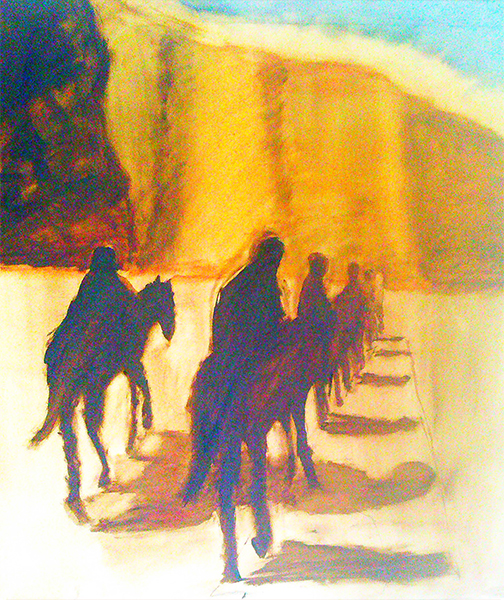
One of Edward Curtis’s famous Native American photos shows a line of Navaho Indians on a horses fading off into the distance. It was entitled, brilliantly, ‘Vanishing Race’
Not only were the individual riders moving towards the vanishing point in the photo but that their whole way of life was vanishing too. Their ‘home’, like that of most Native Americans, had been displaced, to a small reservation, detached from the broad natural canvas of their world.
Seeker of Visions
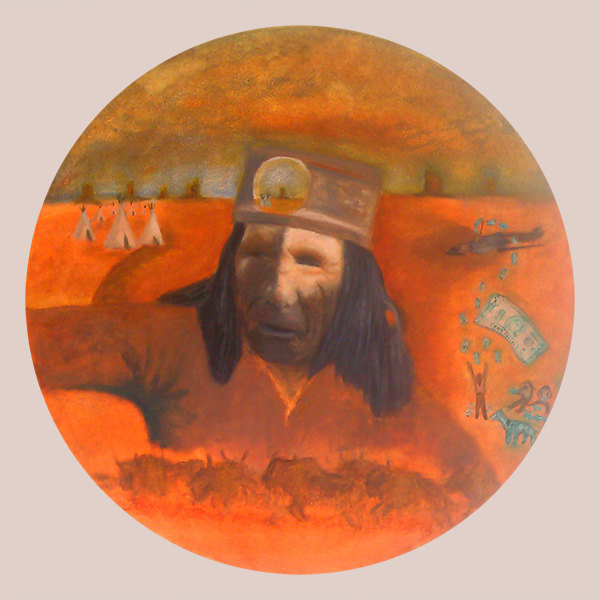
This is my central portrait of Native American thinker Lame Deer (1901/3 -1976) and a representation of the key symbols he mentions in ‘Seeker of Visions’, the book of his thinking as told to his friend Richard Erdoes.
A key symbol is the Native American circle image versus the US square image (think of buildings, boxes, gadgets, our ‘boxed in’ lives, ruled by time etc)
So, my painting had to be on a circular canvas!
Other symbols in the painting are:
Bottom: the buffalo, which are painted very thinly. I was pleased with the ‘cave painting’ effect. The buffalo is a symbol of a way of life and a natural landscape, now lost.
Top left: circles of tipis. Circles within circles here. The tipi literally means shelter and it is a circle itself, a gathering.
On the horizon: the ‘mesa’ and ‘butte’ geological formations of the Badlands landscape of South Dakota. The Badlands were a Sioux hunting ground, for buffalo and other animals
In the sky: the bald headed eagle. A symbol of many natural things in the Native American world. A symbol of money and power on the US dollar and seal.
On the right : a symbolic story….
In 1876, the Lakota lead by Crazy Horse won a rare victory over the US at the Battle of Little Big Horn when Custer’s 7th Cavalry were defeated. The next day, the Indians saw what they described as ‘green frog skins’ drifting up from the uniform pockets of some of the dead US soldier on the battlefield. The Indian children folded these ‘green frog skins’ into little toy horses. The ‘green frog skins’ were the dollar bills by which the US paid the wages of the soldiers.
Spiritual Home
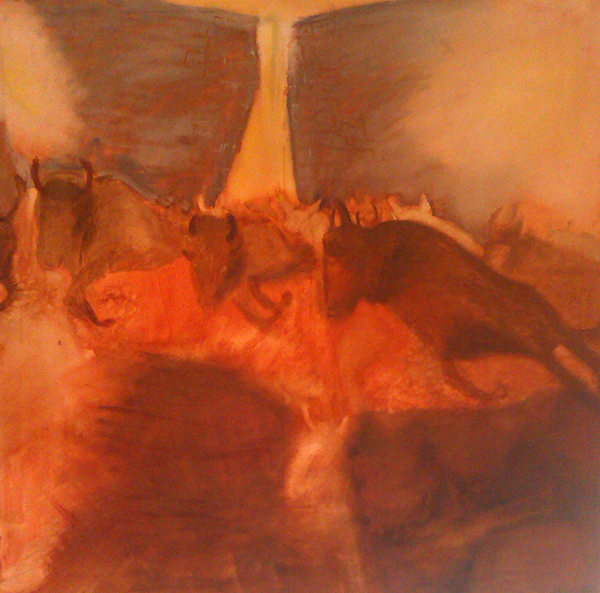
The buffalo (more correctly, taxonomically speaking, the American bison) was a key part of the Great Plains life of the Lakota Sioux.
The Lakota believe that all things contained spirit, not only animals, but also rocks.
It is difficult for us to understand how the Lakota could kill the buffalo in the light of this belief but they saw it as an unavoidable evil in order for them to eat and live, which had to be faced, not avoided.
The spirit of a slain animal still had to be respected, as when the animal was alive: there were ceremonies to reflect this in Lakota lore.
The Lakota chased buffalo ruthlessly, including over ravines (‘pis’kuns’) to kill them more easily. My painting is in part a representation of that. I did not intend to sanitize the Native American ways. However, the US not only killed the buffalo on an industrial scale, due to rifle, railroad, and profit from the mechanisation of tanning methods, but also as sport (as recorded by Custer himself) and ultimately as part of a policy to weaken and destroy a key support of the Native American way of life.
The Spiritual Home also represents where the place where the buffalo spirit lived on after death, and also reflects the buffalo’s place in the landscape.
Green Frog Skins
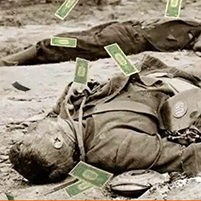
This is a video of montages of images interpreting the Green Frog Skin story provided by me to Mike Cheal, video maker

Lame Deer Colour Palette
